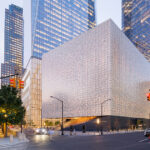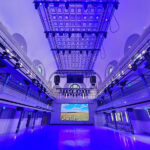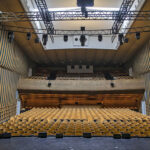"It’s an absolute pleasure to come to work.”
Even in this industry, you don’t hear those words every day. Don’t get me wrong; I love what I do, and I wouldn’t want to do anything else. However, I still get goose bumps when someone says something like this. The person who said this to me happens to be Steve Schofield, the technical director of the Otto M. Budig Theatre at the Carnegie in Covington, Kentucky. A Man On A Mission When I asked him “why,” this is the story that unfolded…
In 1904, The Kentucky Post wrote a review of the newly built Carnegie Theatre, commenting on its modern trappings and the availability of numerous fire exits. Patrons had recently begun to pay more attention to such safety precautions, especially aware of the dangers of quickly spreading fires in such spaces. In December of the preceding year, more than 600 patrons were killed in less than 15 minutes at the (supposedly fireproof ) Iroquois Theatre in Chicago.
Conceived as a Public Library and Civic Auditorium, The Carnegie thrived for the next four decades, until its copper roofing was stripped some time during World War II. The auditorium was eventually shuttered in the late 1950s, not to be re-opened for the next 20 years. Eventually, a group of concerned citizens formed an alliance to convert the historic space into a visual arts center, restoring the library building to be used as a visual art gallery, which is still in use to this day.
Over the next three decades, small improvements and repairs were made to the auditorium, but the small donations could not tackle the trees growing through the stage floor or the vines permeating the plaster of the ceiling. And then six years ago, a man joined the board who would go on to lead a massive and direly needed restoration of the theatre.
1978 Technology? No Thanks.
“Originally, it was going to be kind of an educational theatre. That was pretty much the extent of the mission of it,” says Eric Vosmeier, theatre director at the newly restored Carnegie. Vosmeier, a graduate of local Northern Kentucky University, was brought on board midway through the construction process, and immediately envisioned a much greater role for the newly renovated complex. With a background in facility management, booking and ticketing, it’s no surprise that he saw something a little grander behind the current façade.
“I wanted the position, but I wanted the position if we could step it up quite a bit… bring in some more professional productions, touring concerts, locally produced theatre and other things like that,” Vosmeier said. “So we had to go in and do almost a re- re-design based on how much money we had, and based on how much time we had remaining during the renovations, because we did have a deadline to complete it.”
Vosmeier says that in his first week on the job he requested an extra onehundred- thousand dollars a day for the first five days he was there. Considering the impact of this on the $2.5 million dollar budget, it comes as no surprise that Vosmeier’s requests quickly became an inside joke for the rest of the staff at The Carnegie. The team eventually cut the entire lighting package that had been originally spec’d, which consisted of 36 dimmers and a two-scene non-programmable controller.
“It was a really great board in 1978,” says Schofield.
The package was quickly replaced by a full-featured system consisting almost entirely of ETC components. With a new 96-way Sensor rack, an Expression 3 console, and a full complement of Source Four fixtures to be installed in the space, Vosmeier had to quickly re-initiate himself in the hands-on aspects of technical theatre.
“This was before I had Steve on the staff, and a lot of this stuff I had to kind of go through and re-educate myself on. I hadn’t had a great deal of ‘tech’ learning since I was in college.”
Schofield says, “Eric approached me in December. We talked about it, and it seemed like a really good move for me. It’s a technician’s dream to run your own theatre. I accepted the position and I started here in January.”
Schofield quickly became an integral part of the team, digging into the details of each technical system to make sure they were installing the right products in a way that would support all types of productions in the space. “At that point,” says Schofield, “Eric and I went over some of the changes he had talked about, and I talked about some of the things that I wanted and that I thought the venue needed to function. At this point, a lot of the spec had been written by the vendors. They kept pushing the Crestron system on us for video and I just did not want that.”
Schofield told the vendors, “I want a 4- channel T-bar switcher, so I can do smooth transitions with effects in it. It actually ended up saving us some money because the Crestron system was so expensive. So, we actually went to the Sanyo projector that we’ve got and I’ve got an Edirol switcher which is relatively inexpensive.”
While the duo reported no major conflicts with their vendors, it did take a little extra effort to make it clear to these contractors that they were dealing with professionals. “The thing they kept telling me,” Schofield says, “was ‘Well, this is idiot-proof.’ I looked at them and said, ‘Well, I’m not an idiot.’ ”
From Children’s Theatre to Roadhouse
To expand the lighting audio, and video systems beyond the original scope of the children’s theatre, Vosmeier convinced the board of trustees that his vision of a 465-seat roadworthy house was not only possible, but maybe the most important aspect of the ven- ue. Even with that support, money was not growing on trees—not even the ones growing through the floor-boards.
“I presented a full budget for redesign. I said ‘These are the things that I think we need.’ I padded it with a little bit of stuff that would have been really nice to have, and those are the few things that I ended up cutting,” Vosmeier says. “A lot of it was just creating new front-of-house locations for lighting, because we only had that one. We now have one right in front of the booth (the main one we had before), we have three that under-hang the mezzanine, we have two high-side positions in the mezzanine, and two high-side positions in the rear mezzanine.
“The board, the architects and the contractors took some convincing, but in the end they really became supporters of what we were doing, and decided that we had the correct ideas. Everyone is now really excited about what we can do with the space that we wouldn’t have been able to do before.”
220, 221, Whatever It Takes
One of the largest challenges the team faced was the size of the electrical service coming in to the building. “Because of the age of the building and the limits of the amount of power available, we actually can not add dimmers without bringing in a new service,” says Schofield. With a cost of $50-60,000 to bring a new service into the building, the building will not likely see an upgrade of this kind in the foreseeable future.
To provide the greatest flexibility, Schofield decided to eliminate the standard circuittrough system seen in most theatres. Working with a supplier in Las Vegas, Schofield installed a system of multi-circuit cable with Socopex connections at the various lighting positions. Using fifty-foot multi-core extensions and staggered break-outs, circuits can be easily dropped at any location.
“So on my electrics, I can just run these Socos out and drop them down. And now I can turn every pipe over the stage into an electric,” says Schofield. “They’re not taking up any space, and they were probably half the cost of these circuit boxes.”
To prevent shoving matches between the audio and lighting departments, the entire audio system was put on an isolation transformer. Schofield’s also hoping to take advantage of some more modern technology in his battle against the ammeter. “At this point,” he says, “with the thirty-six circuits I have over the stage, it doesn’t really allow for any cyc lights. I’ve been looking at Color Kinetics, going to some LED cyc lights, because I know I can put all of them on one circuit. Because of the power limitations, I think that some of the LED technology that’s been coming out is really going to help me get what I need without having to add dimmers.”
A future three-phase service addition would also help Schofield in other ways. “The potential for me to put four chain motors in would give me the ability to put in an upstage and a downs t a g e truss to give it more of a rock ‘n’ roll look when we start doing more of our concert series. But, at this point I do not have any three-phase service or 220-volt service on stage that I can tie in to. That is something that I’m still looking into.”
Amazing Space, How Sweet the Sound
With the theatre recently celebrating its grand re-opening, Vosmeier and Schofield seem pleased with the state of the facility and optimistic that they are now wellprepared to handle any show that comes their way. With a handful of musical productions and community events under their belts, Vosmeier is now taking a look into the future, working on deals with some national touring groups and hoping to attract a wider array of performances than the board ever hoped for.
Says Schofield, “Most of the guys I’ve talked to who have come in to see me, have commented on what a dream job it is that I now have. I think with both Eric and I, it’s an absolute pleasure to come to work. We actually find ourselves spending more time here than we probably should, but it is an absolutely amazing space.”
Phil Gilbert is a freelance lighting designer / programmer. He can be reached at pgilbert@ plsn.com.


